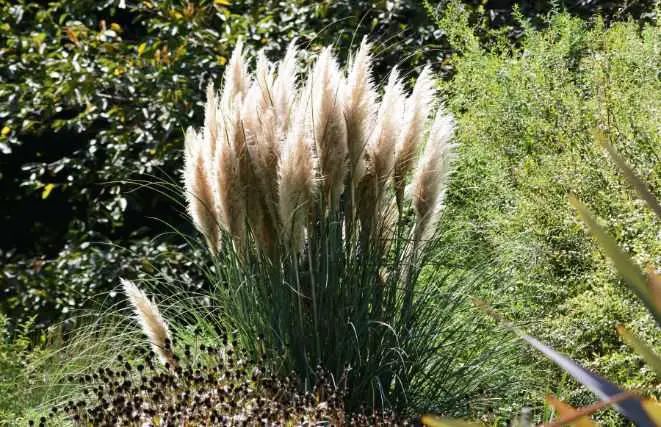Blue Bayou Pampas Grass is something to think about if you want to give your garden a special touch. This ornamental grass can bring color and texture to any landscape thanks to its eye-catching blue-green foliage and towering, fluffy plumes.
What is Blue Bayou Pampas Grass?
The attractive decorative grass species Cortaderia selloana is also known as Blue Bayou Pampas Grass or Cortaderia selloana ‘Blue Bayou’. This variety stands out for its unusual blue-green leaves, which gives gardens a fun alternative to the usual green and white pampas grass.
How to Grow Blue Bayou Pampas Grass
Hardy Blue Bayou Pampas Grass can reach heights of 6 to 8 feet and widths of 4 to 6 feet, making it a great option for big gardens or as a focal point in smaller landscapes. It can grow in USDA growth zones 7 to 11, preferring full sun, but can tolerate moderate shade.
| Common Name | Blue Bayou pampas grass |
| Scientific Name | Cortaderia selloana ‘Blue Bayou’ |
| Height & Spread | 6-8 ft tall, 4-6 ft wide |
| Light | Full sun to partial shade |
| USDA Growing Zones | 7-11 |
| Soil | Well-drained soil, pH 6.0-7.5 |
| Water | Moderate to low |
Blue Bayou Pampas Grass is comparatively adaptive to soil conditions and may thrive in a range of soil types, from sandy to clay. But it favors well-draining soil that is just right—not too moist or dry. When it comes to watering, this grass is drought-tolerant and, once established, may survive for extended periods of time without water.
Despite the fact that Blue Bayou Pampas Grass is mostly free of pests and illnesses, it’s still vital to watch out for rust or fungal infections, which can occasionally afflict pampas grasses. Planting your Blue Bayou Pampas Grass in an area with good airflow and avoiding overhead watering will help you avoid these problems.
When to Plant Blue Bayou Pampas Grass
The best time to plant Blue Bayou Pampas Grass is in the spring or fall when temperatures are mild. If you live in an area with hot summers, it’s best to plant in the fall to allow the plant to establish itself before the hot weather hits.
Blue Bayou Pampas Grass requires only moderate upkeep. It just has to be cut back in late winter or early spring to remove any dead or damaged foliage. It also requires little to no watering.
Is blue pampas grass real
Blue Pampas Grass (Cortaderia selloana ‘Pumila’) is a cultivar of Pampas Grass that is often referred to as “blue” due to its bluish-green foliage. However, it’s important to note that the term “blue” in this context is a description of the color tone rather than indicating a true blue color. The foliage of Blue Pampas Grass has a bluish hue that sets it apart from the standard green color of other Pampas Grass varieties. The plumes of this grass are typically cream or white in color. So, while Blue Pampas Grass is not truly blue, it is a popular variation of Pampas Grass known for its unique foliage coloration.
FAQ
Real pampas grass (Cortaderia selloana) typically comes in natural creamy white, beige, or light brown colors. However, there are some cultivated varieties of pampas grass, such as Pink Pampas Grass and Golden Pampas Grass, which have been bred to produce pink or golden-colored plumes, respectively. Other ornamental grasses, such as Purple Pampas Grass and Silver Pampas Grass, have been hybridized to produce a range of colors, but these are not considered “real” pampas grass. It’s important to note that some online retailers may falsely advertise dyed pampas grass, so be sure to do your research and purchase from a reputable source if you are looking for natural-colored pampas grass.
While the majority of Pampas Grass (Cortaderia selloana) varieties have white or creamy-colored plumes, there is a variety known as “Blue Pampas Grass” (Cortaderia selloana ‘Pumila’) that is often referred to as blue. However, it’s important to note that the term “blue” in this context is a description of the color tone rather than indicating a true blue color. The plumes of Blue Pampas Grass are typically a silver-gray or silvery-blue color, giving them a distinct and unique appearance compared to the more common white varieties. So, while it may not be a vibrant or true blue, Blue Pampas Grass can offer a different and visually appealing color variation.
Yes, Pink Pampas Grass (Cortaderia selloana ‘Rosea’) is a real variety of pampas grass. It is a cultivated hybrid that has been selectively bred to produce pink-colored plumes instead of the natural creamy white or beige color. Pink Pampas Grass can grow up to 10-13 feet tall and is hardy in USDA zones 7-11. It prefers full sun exposure, well-draining soil, and regular watering during its growing season. Pink Pampas Grass can be a beautiful and eye-catching addition to any landscape or garden.
Final Thoughts
Overall, Blue Bayou Pampas Grass is an interesting and attractive addition to any garden. Any environment can benefit from its eye-catching blue-green foliage and fluffy plumes, which add color and texture. Additionally, it requires little maintenance, making it a fantastic option for people who want to add a little drama to their garden without having to do a lot of maintenance.









